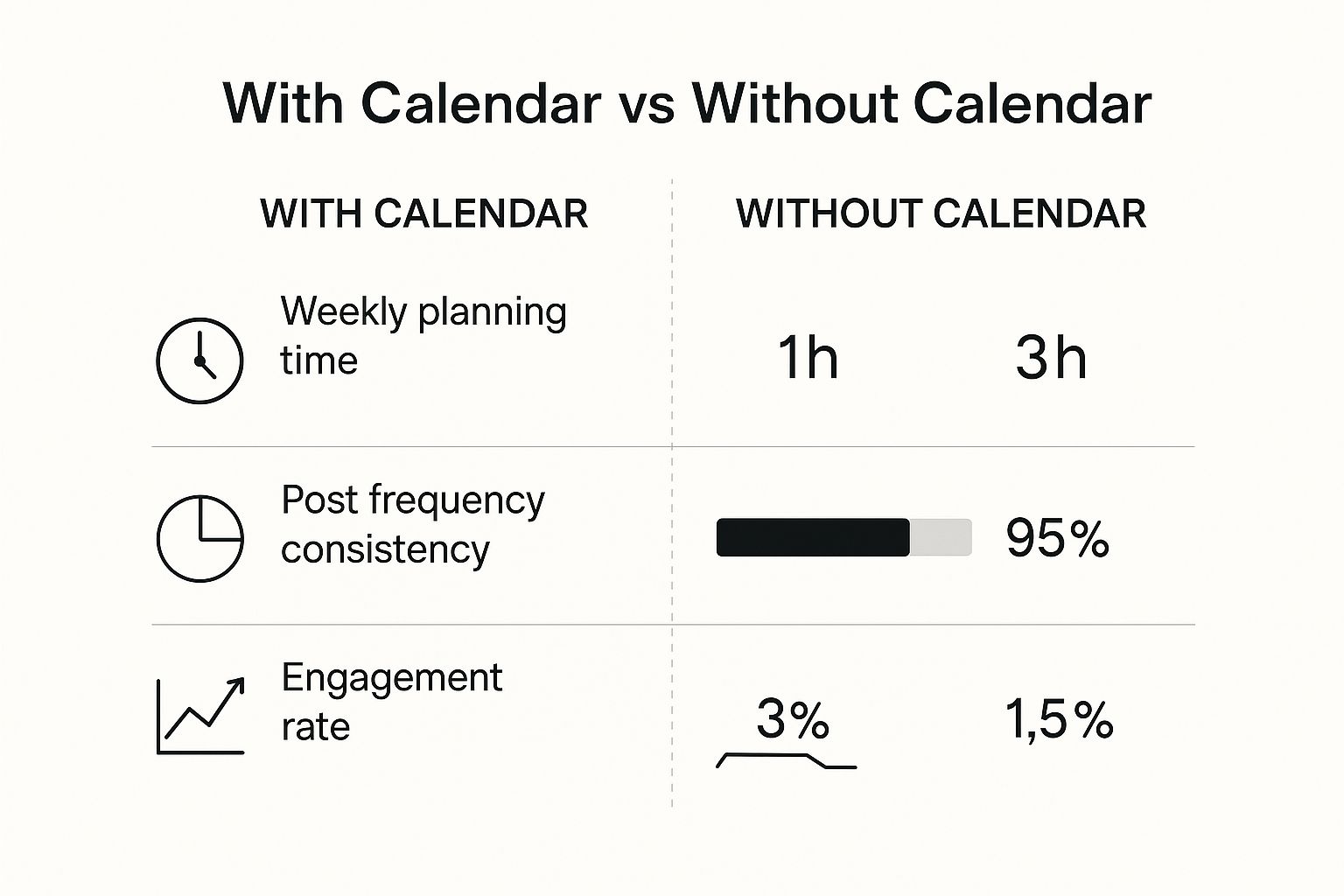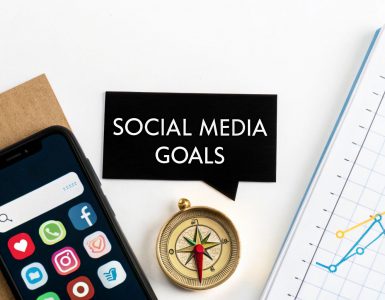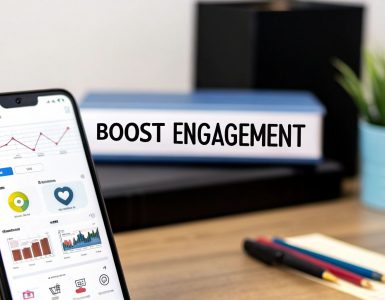Think of a social media content calendar as your team's game plan for everything you post. It's what turns a scattered, "what do we post today?" scramble into a smart, coordinated strategy. A great calendar ensures your brand always sounds like itself and that you never miss a chance to connect with your audience.
Why a Content Calendar Is Your Secret Weapon

Let's be real—posting on the fly is stressful. One day you’re desperately hunting for something, anything, to share, and the next you realize you completely forgot to promote a major product launch. A content calendar for social media flips that script, turning a reactive chore into a powerful engine for growth.
Picture two different brands. Brand A posts whenever they remember to, their tone is all over the place, and their feed is a jumbled mess of random ideas. Brand B, on the other hand, uses a content calendar. Their posts feel intentional, they support bigger marketing campaigns, and they show up for their audience consistently. Over time, who do you think builds the stronger, more loyal community? It's Brand B, every time.
This isn't just about getting organized. It’s about building a strategic asset that gives you a real competitive edge in a very noisy world.
Go From Messy to Methodical
The biggest win here is trading chaos for consistency. When you plan your content, your brand's voice, visual style, and core messages stay steady across every platform. That kind of consistency is absolutely essential for building brand recognition and earning your audience's trust.
And you definitely want to earn their attention. Projections show that global users will spend a mind-boggling 14 billion hours daily on social media in 2025. You can't capture a sliver of that time with a haphazard approach. A calendar is your tool for showing up reliably where your audience already is.
Boost Teamwork and Get More Done
When everyone on your team can see what's coming up, the calendar becomes your single source of truth. It aligns your writers, designers, and managers around deadlines, campaigns, and who's responsible for what. No more last-minute emergencies or posts going live without the right person signing off.
This level of coordination is even more vital in certain fields, like education, where the academic year dictates the schedule. For those in that space, this expert planning guide for a social media calendar is a fantastic resource with tailored insights.
Ultimately, by planning and creating content in focused blocks, you save a ton of time. This frees your team from the relentless content treadmill, allowing them to focus on higher-value work like engaging with followers, analyzing what works, and refining your overall strategy.
Let’s quickly look at the immediate wins you get from implementing a calendar.
At-a-Glance Benefits of a Content Calendar
| Benefit | Impact on Your Marketing |
|---|---|
| Strategic Cohesion | Ensures all posts support larger business goals, not just fill a slot. |
| Improved Consistency | Builds a reliable brand presence that your audience can trust and recognize. |
| Time Savings | Batching content creation frees up hours for community management and analysis. |
| Enhanced Collaboration | Provides a clear, shared roadmap that keeps the entire team aligned and accountable. |
| Error Reduction | Allows for proper review and approval, catching typos and mistakes before they go live. |
In short, a content calendar is far more than a simple schedule; it’s a strategic framework that brings order, efficiency, and real impact to your social media efforts.
Defining Goals That Drive Your Content

Before you even think about adding a single post to your schedule, we need to take a step back. A truly effective content calendar for social media isn't built on random posts just to fill a slot. It's built on a foundation of clear, well-defined goals. Without a destination in mind, you're just creating content for the sake of it—and that’s a fast track to burnout and disappointing results.
The first move is to connect your social media efforts to real business outcomes. This means looking past vanity metrics like "more followers" or "more likes." Sure, those numbers can feel good, but they don't directly pay the bills. Your goals need to be specific, measurable, and genuinely impactful.
Key takeaway: A goal-first approach ensures every single piece of content you plan has a clear purpose and a direct line to business growth. Forget chasing vanity metrics and start tracking what actually matters.
From Vague Ambitions to Specific KPIs
Tying your high-level business ambitions to specific Key Performance Indicators (KPIs) is where the magic really happens. Your KPIs are the measurable values that demonstrate how effectively you're hitting your main objectives. This is how you turn a fuzzy wish like "get more customers" into a concrete, actionable plan.
Let's look at how you can map common business goals to the KPIs you’ll track on social media:
- Goal: Increase Brand Awareness
- KPIs: Post reach, impressions, share of voice, audience growth rate.
- Goal: Drive Website Traffic
- KPIs: Link clicks, click-through rate (CTR), referral traffic from social channels.
- Goal: Generate Qualified Leads
- KPIs: Form submissions from social links, downloads of gated content, webinar sign-ups.
Getting this level of detail right is a vital part of your bigger strategy. If you want to go even deeper, our guide on how to create a social media plan walks through this entire process from start to finish.
Putting Goals Into Practice
Let’s put this into a real-world context. Imagine you run a B2B software company, and your primary goal for this quarter is lead generation. With that objective locked in, every post you add to your calendar should be designed to support it.
This means you’ll skip the generic industry news and instead prioritize content that actively captures leads.
Suddenly, your content mix becomes much clearer:
- Webinar Promotions: You'd create posts with a direct call-to-action to register for an upcoming product demo. The key metric to track here is the number of sign-ups that come straight from your social media links.
- Case Study Teasers: Think short video clips or sharp graphics that highlight a major customer win. The post would then link to the full PDF, which sits behind a simple email gate. Your KPI? The number of downloads.
- Blog Post Shares: You would promote in-depth articles that solve a huge pain point for your ideal customer. The article itself would have a lead-capture form embedded on the page, letting you measure both landing page visits and form conversions.
See how that works? When you define the goal first, the right type of content practically suggests itself. Your content calendar is no longer just a schedule—it’s a strategic roadmap for hitting your most important business targets.
Choosing the Right Calendar Format for Your Team
Let's be honest—there isn't a magical, one-size-fits-all format for a social media content calendar. The best tool is simply the one your team will open up and use every single day without groaning. Picking the right format really comes down to your team's size, how complex your workflow is, and what your budget looks like.
For a solopreneur or a small business just getting its feet wet, a simple spreadsheet in Google Sheets or Excel is a fantastic starting point. It’s free, everyone knows how to use it, and you can get a basic system up and running in minutes with columns for date, platform, copy, and visuals.
But as your social media strategy gets more ambitious or your team expands, you'll start to feel the limitations of a spreadsheet. Trying to manage approvals, track creative assets, and keep campaign threads from getting tangled can turn a neat grid into a real headache. That’s when it’s time to look at dedicated calendar and project management tools.
Just look at the difference a dedicated calendar can make. It’s not just about organization; it’s about performance.

The numbers speak for themselves. Teams with a structured calendar don't just slash their weekly planning time in half; they also post more consistently and see a 100% increase in engagement. That’s a massive return for getting organized.
Leveling Up Your Calendar Tools
When your spreadsheet starts to feel more like a constraint than a tool, it’s a clear sign you’re ready for an upgrade. This is where more dynamic options like Trello, Asana, or Airtable come in, transforming your static grid into an interactive workspace.
There are many great options out there, each with its own strengths. The key is finding the one that fits your team's natural workflow.
Content Calendar Format Comparison
| Format/Tool | Best For | Key Advantage | Potential Drawback |
|---|---|---|---|
| Spreadsheets | Solo creators & very small teams | No cost, easy to set up, and highly familiar. | Becomes messy with collaboration; no automation. |
| Trello | Visual thinkers & teams with a clear workflow | Kanban boards make it easy to track post status. | Can feel too simple for complex project needs. |
| Asana | Larger teams with complex approval chains | Excellent for task assignment and dependencies. | Can have a steeper learning curve for new users. |
| Airtable | Data-driven teams wanting customization | A powerful hybrid of a spreadsheet and database. | Might be overkill for very simple content plans. |
Ultimately, picking the right platform comes down to what will make your team's life easier.
The goal is to choose a tool that reduces friction, not adds to it. If your team spends more time fighting with the calendar than creating content, you’ve picked the wrong format.
Choosing your format is a critical first step, but it’s just one part of a bigger picture. To see how this fits into a broader content strategy, check out our guide on how to create a marketing calendar for your blog, which shares principles that apply directly to social media planning.
My best advice? Start simple. See what works, get feedback from your team, and don't hesitate to switch tools as your strategy and team evolve. The perfect calendar for you today might not be the perfect one a year from now, and that’s okay.
Ever stared at a blank content calendar, feeling that familiar sense of dread? We’ve all been there. The best way I've found to beat that content paralysis is by setting up content pillars—the core themes that become the foundation for everything you post.
Think of them as the main sections in your brand's own magazine. Instead of desperately trying to invent a new post idea every single day, you’ll have these reliable, strategic buckets to pull from.
What Are Content Pillars, Really?
Content pillars are simply the 3-5 broad topics your brand has earned the right to talk about. The sweet spot is where your business goals, your brand's unique voice, and what your audience actually wants to see all meet. Nailing these pillars is the secret to a content calendar for social media that you can stick with for the long haul.
For instance, a local gym wouldn't just post random workout clips. Their pillars might be something like:
- Workout Demos: Quick, effective exercises anyone can do.
- Nutrition Myths: Busting common diet fads and offering real advice.
- Member Spotlights: Celebrating real people and their progress.
- Mindset & Motivation: The mental side of fitness and staying consistent.
See how each pillar supports the main goal (getting new members) but offers a great mix of educational, inspiring, and community-driven content?
Finding Your Core Brand Themes
Getting your pillars defined is a team effort. Grab your team, get in a room (or a Zoom call), and just start riffing on these questions. The rule is no bad ideas at this stage—just get it all down.
- What problem are we really solving for people? Your content should be a direct answer to their biggest headaches.
- What are our customers passionate about that relates to our world? Think bigger than just your product; consider their entire lifestyle.
- What do we know that nobody else does? This is your chance to show off your expertise and build real authority.
- What makes our audience laugh, or feel inspired? Connection is just as important as conversion.
Once you have a massive list of raw ideas, start grouping them into related themes. You'll quickly see 3-5 strong, distinct pillars emerge. As you brainstorm, don't be afraid to think outside the box. For example, exploring new trends like creating AI influencers could become a totally unique pillar for a tech-forward brand.
Here's a pro tip: A solid content pillar is a deep well, not a shallow puddle. You should be able to easily brainstorm at least 10-15 specific post ideas for each pillar. If you're struggling, your pillar might be too specific or narrow.
Weaving Your Pillars into the Calendar
A great social media calendar doesn't just rely on pillars; it also syncs up with what's happening in the world. For 2025, smart marketers are already planning to mix major holidays with fun, niche celebrations to keep things interesting.
Think beyond the big ones. Dates like World AIDS Day (December 1) or even National Cookie Day (December 4) can be powerful opportunities to connect, show your brand’s human side, and engage your audience in a different way. You can dig into more ideas for using these kinds of dates over on Vamp.com.
This forward-looking approach keeps your content pillars from feeling stale. You can plan special mini-campaigns around these dates that still fit perfectly under your core themes, ensuring your feed is always fresh, relevant, and strategic. This framework makes content creation faster and way more consistent.
Finding Your Ideal Posting Rhythm

Alright, you've set your goals and mapped out your content pillars. Now for the fun part: figuring out a posting rhythm that actually works without burning you out.
Let's get one thing straight—the idea of a universal "best time to post" is one of the biggest myths in social media. Those industry benchmark reports can be a decent starting point, but they’re not a magic bullet for your specific audience.
Real success comes from discovering when your followers are actually online and ready to engage. This means you have to stop guessing and start digging into your own analytics. The answers you're looking for are already there, waiting in your data.
The point isn’t just to post whenever you have a free moment. The goal is to show up when your audience is actually listening. A good rhythm gets you maximum reach without overwhelming your team or your followers.
So, How Often Should You Really Be Posting?
This is the million-dollar question, and the answer is a classic "it depends." It's a balancing act. If you post too infrequently, you'll fade into the background. But if you post too often, you risk annoying people enough that they hit the "unfollow" button. The right cadence comes down to the platform you're on, your industry, and what your team can realistically handle.
For instance, some data shows that businesses in fields like construction or manufacturing post on Facebook around 7.9 times a week. Meanwhile, consumer goods brands are often posting closer to 9.0 times weekly. This just goes to show how different the expectations can be from one industry to another.
At the end of the day, your own analytics are your most reliable guide. Dive into your Instagram Insights, Facebook Analytics, or TikTok analytics to see when your followers are most active.
Find Your Sweet Spot with Analytics
Start by heading straight to the "Audience" or "Insights" tab on your social platforms. Most of them have a simple chart that shows you exactly when your followers were online over the last week. This is your starting line.
Here’s a practical approach to finding your rhythm:
- Look for Your Peaks: Pinpoint the days and times when you see the biggest spikes in audience activity. These are your golden hours.
- Test and Measure: For a few weeks, intentionally schedule your most important content to go live during these peak times.
- Analyze What Happened: Circle back and review the engagement on those posts. Did they get more likes, comments, and shares than posts published at random times?
- Refine and Repeat: Use what you learned to fine-tune your schedule. You might discover that Tuesday mornings are perfect for educational tips, while Friday afternoons are prime time for something more fun and lighthearted.
Don't think of this as a one-and-done task. People's habits change, so make it a point to check your analytics every quarter to make sure your schedule is still on point.
Building a smart posting schedule is a fundamental piece of the puzzle. For a more comprehensive look at putting all the pieces together, our guide to creating a social media content calendar is a great resource.
By leaning on your own data, you can build a responsive, intelligent schedule that gets your great content in front of the right people at the best possible time.
Making Your Content Calendar Work for You
Let's be real. Even the most perfectly organized content calendar for social media will eventually collide with reality. A meme explodes overnight, your boss has a last-minute "great idea," or someone on the team just plain forgets to check the schedule. It happens.
The secret isn’t to create a rigid, unbreakable plan. It's to build a flexible framework that can bend without breaking. This is where your calendar truly shines—not as a set of strict rules, but as a living document that guides your strategy, even when things get a little chaotic.
Handling Last-Minute Changes
Unexpected news and timely opportunities aren't disruptions; they're part of the game. Instead of letting them derail your entire week, you need a process to manage them.
Over the years, I've found the best way to do this is with a dedicated "fast-track" approval workflow. When a post needs to go live now, it shouldn't have to wait in the same line as a blog post planned weeks ago. It should skip the standard, multi-day review and go straight to one or two key people who can give a quick thumbs-up. This keeps you nimble without creating a free-for-all.
Getting Your Team Onboard
A content calendar is worthless if your team ignores it. To get genuine buy-in, the tool has to make their lives easier, not add another tedious task to their plate. The best way to start is by including them in the selection and setup process.
Once you’ve chosen your platform, you need to establish it as the single source of truth for everything social media.
- Centralize Everything: All creative assets, copy drafts, and final links should live directly within the calendar. No more frantic searching through old emails or Slack DMs.
- Automate Notifications: Let the tool do the nagging for you. Set it up to automatically ping team members when a task needs their attention or a post is ready for review.
- Run Meetings from the Calendar: Pull up the calendar on the main screen during your weekly social media syncs. This visually reinforces its role as the central hub for all planning and discussion.
A critical mistake is treating the calendar as just a scheduling grid. It should be your team's collaborative workspace. When it becomes the easiest place to find information and get approvals, people will naturally start using it.
How Far Ahead Should You Plan?
This is the classic balancing act. If you plan too far out, you risk sounding out of touch. But if you don't plan far enough, you're stuck in a constant state of panic.
Here’s a practical rule of thumb I’ve settled on: plan your big-ticket content—like blog promotions, campaign launches, or video premieres—about one month in advance. This gives your creative team the breathing room they need.
For your more timely, reactive content, a one-to-two-week planning window is the sweet spot. It provides enough structure to keep you organized but leaves plenty of room to jump on trends or current events.
Ultimately, your calendar is a tool to empower your team. It frees you from the daily grind of figuring out what to post, ensures a consistent level of quality, and keeps everyone aligned. By thinking through these common challenges upfront, you can build a calendar that truly works for you.
Ready to stop scrambling and start scheduling smarter? EvergreenFeed automates your evergreen content, filling your social media calendar with high-value posts so you can focus on what matters most. Start your free trial today and put your content to work.




